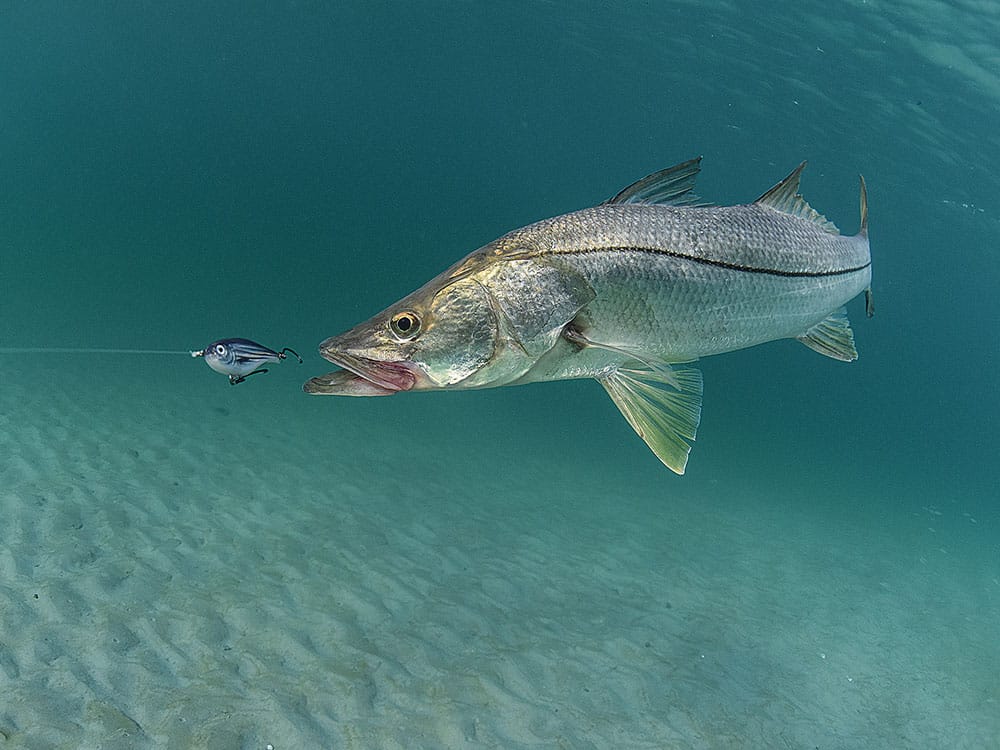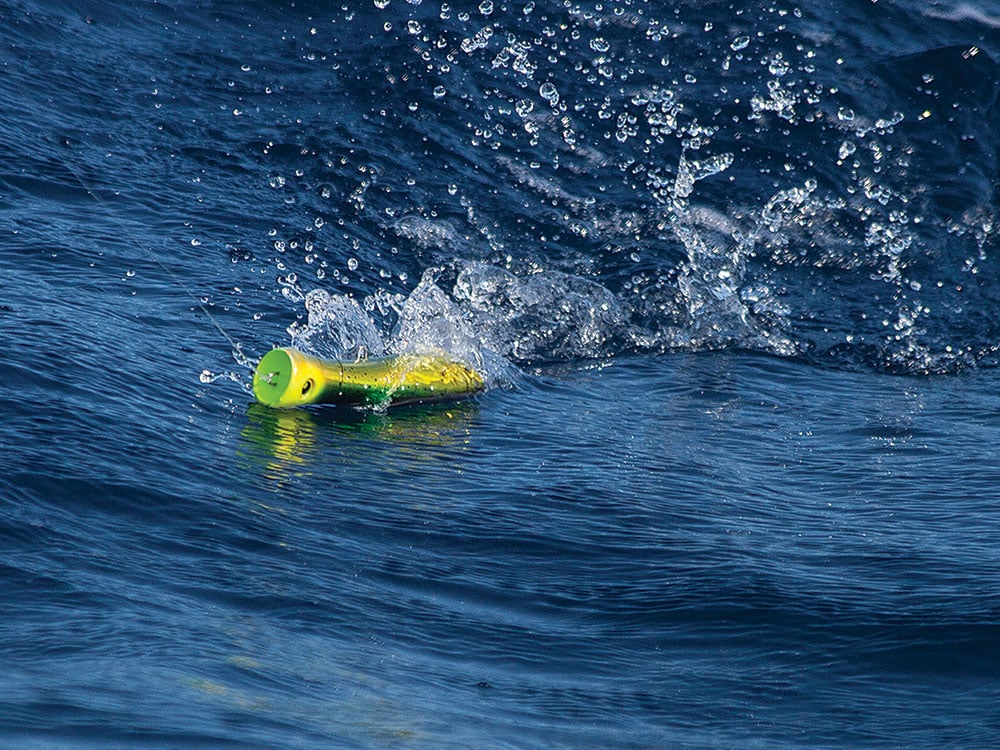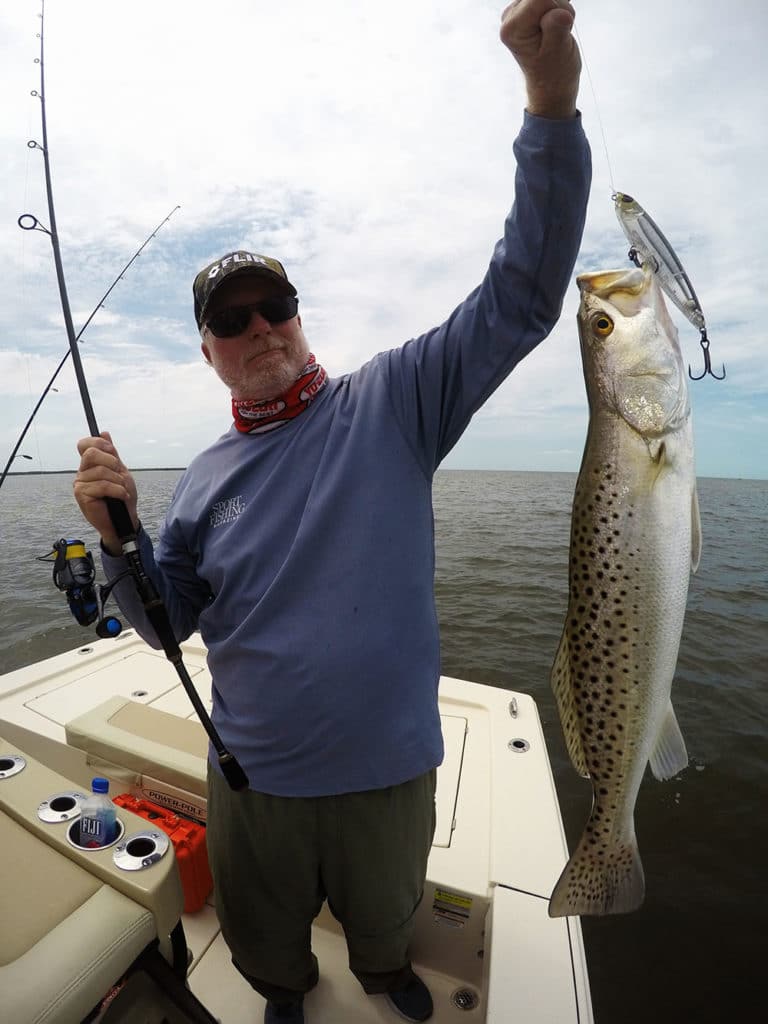
A lure that swims flawlessly prevents tackle tangles and skittish game fish, illustrating that proper presentations are the most important factor when retrieving lures. Lures spinning in the water erroneously because of sloppy rigs, incorrect hook modifications or improper retrieval speeds can create line twist and fishless days.
Thankfully, a quick test next to the boat can tell you if a lure is swimming correctly. Anglers should take the next step and match the retrieval speed based on the conditions. Most lures require unique presentations based on different types of retrieves — not every soft plastic needs a steady retrieve back to the boat, and not every hard bait demands spastic action.
We asked expert captains and fishing professionals how different speeds affect their lure presentations. Is it better to be the tortoise or the hare?
Pacing Hard Plastics

With any lure, let the fish show you what retrieval speed they want by varying speeds until a fish connects with your presentation.
“Say I’m walking a lure such as a Rapala Skitter V across a shallow bar. I’ll start with a slow, steady retrieve,” says Bernie Schultz, a veteran saltwater angler, BassMaster Elite Series pro and lure collector. “I may pause the lure at times, but the pace is mostly slow at first. If I get a quick, aggressive reaction from the fish, then I’ll speed up the retrieve or give the lure sharper snaps with the rod tip to create commotion.”
Without feeding responses from increased retrieval speeds, he’ll slow down the plug again and pause the lure at key points near pier pilings, sand holes in a grass flat or irregularities along a shoreline.
“A steady twitching cadence is how I initially start working my jerkbaits, then vary from that speed according to how the fish react,” says Schultz. “That goes for most species, when casting suspending or ultraslow-sinking lures.” Some species, such as seatrout, prefer specific actions, often hitting a lure at rest between pulls.
“For whatever reason, trout occasionally prefer the lure lying dead still, especially when water temperatures are extremely hot or cold,” says Schultz. “That’s the best time to throw a jerkbait. There’s something about a small profile and flash, hanging in the strike zone, that really triggers a reaction.” Other species, such as Spanish mackerel, prefer a more aggressive, erratic action, especially if fish are actively feeding on or near the surface.
“I go with a fast retrieve during a surface-feeding fray,” says Schultz. “Usually the quicker you get your lure in there, the better. That goes for all types of schooling game fish.”
Sight-Casting Success

When fish are in plain view, sight-fishing requires different tactics.
“On grass flats, redfish hang along the edges and you have to slow your baits down,” says Mark Cowart, who fishes pro redfish tournaments with his son, Capt. Michael Cowart. “When you spot them facing into the current, make sure to quarter the bait to the fish.”
Mark prefers to cast baits that imitate sandworms and crabs, utilizing Z-Man Finesse TRDs and Palmetto BugZ, respectively, both freshwater soft baits.
Michael uses a speedier presentation to locate fish via blind-casting, then switches to a slower presentation to seal the deal.
“I fish the Z-Man PaddlerZ quickly, just below the surface, to force reaction strikes,” says Michael, of Shallowtails Adventures in Panama City Beach, Florida. “If they miss the bait but swirl or wake on it, cast back to the spot and let the bait drag slowly along the bottom.”
Water temperatures affect Capt. Lynn Zirkle’s sight-fishing tactics. Fishing Tampa Bay waters on Florida’s west coast, Zirkle presents baits faster in warm waters and slower in cool waters. “In Florida, below 70 degrees is cool and above 80 degrees is hot,” jokes Zirkle.
Besides seasonal trends, temperatures throughout the day affect retrieval speeds. In the morning, Zirkle works surface baits slowly. In the afternoon and evening, he jumps to subsurface baits, such as the LiveTarget Scaled Sardine twitchbait, and soft swimbaits for faster retrieval speeds.
Fishing for linesiders is a perfect example. When sight-fishing for snook along a beach during the sizzling summer months, Zirkle works the bait faster, especially in conjunction with tide movement. But in the backwaters, he works jerkbaits much slower along docks and mangroves.
“When sight-casting, the safest approach is to start with a slow retrieve,” says Zirkle. “Make sure the lure is well ahead of the fish — not on top of its head — and when the fish starts to follow the bait, then speed up the retrieval. Speeding up the lure retrieve once a fish locks on mimics a fleeing baitfish, and a quick twitch or rest during the retrieve can entice the bite.”
Perfecting Poppers and Stickbaits

Calm surface waters are ideal for most popping styles because conditions won’t hamper your ability to work the plug. Rough water, however, can cause a popper with a large head to tumble in the troughs. Popper fishing really thrives with two types of fish species.
“For me, it’s aggressively feeding fish on the move, or deeper-holding fish with the potential to launch into aggressive feeding behavior,” says Capt. Jack Sprengel, of East Coast Charters in Rhode Island.
“Aggressively feeding fish include tunas, jacks and even bluefish, while the explosive strikers that hold in current or orient to structure comprise species like cubera snapper, wahoo and mahimahi.”
Capt. Jamie Thinnes, of Seasons Sportfishing in San Diego, California, targets bluefin tuna from 40 to 70 pounds at the surface when his local waters hit 66 to 68 degrees.
“The ‘foamers’ are those tuna attacking anchovies at the surface,” says Thinnes. “‘Puddler’ tuna also hang at the surface, creating ripples but not necessarily eating. Feeding tuna hit plugs almost immediately, destroying the lure when it hits the surface.”

Thinnes watches for followers behind surface lures such as the Shimano Coltsniper. If he gets bumped on the retrieve, he’ll speed up the lure even faster. No bites at all are a sign the retrieve is too fast, or the tuna are simply puddling at the surface.
Sprengel tries to emulate the speed of fleeing baitfish. “The key with [surface feeders] is for the lure to hit the water moving, consistent with your patterned speed,” says Sprengel. “Slow it down or speed it up in a pattern; once you get their attention, keep it there.”
When casting a popper near structure, start the retrieve with long, deep sweeps of the rod, quickly taking up the slack line. The long, deep sweeps are perfect for grabbing the attention of the deeper-holding or structure-oriented fish, and often result in a large swirl behind your plug.
“Once a large boil forms behind the lure, begin a series of fast, erratic chops, acting like an injured or disoriented baitfish, and you will likely be rewarded with a classic, full-body breach [attack],” says Sprengel.
A fishing lure is only as effective as the angler applying the action. Be creative and mix up retrieves until you fool fish into striking. If fish are receptive, you might be able to work the bait without much thought. But when fish get picky, that’s the time to try to figure out necessary changes in how you retrieve your lures.
Five Things to Remember About Working Topwater Lures

Try not to stop reeling after a miss. The sudden halt can turn fish off the chase almost immediately. Conversely, don’t get so excited that you rip the lure away from them.
Fish the plug right to the boat. Fish often follow a bait, especially after missing it a couple of times during the retrieve.
If you see a fish strike your topwater, set the hook only when you feel the weight of the fish tight to your line. Setting the lure too early often pulls the bait from the fish, even with treble hooks.
When you come tight to the fish, give it one or two quick sets. Don’t swing for the fences or do 30 hook-sets.
Use a slightly heavier leader when popping, compared to jig or subsurface baits. Popping imparts increased stress on the leader system; heavy mono is ideally suited for this type of fishing.








